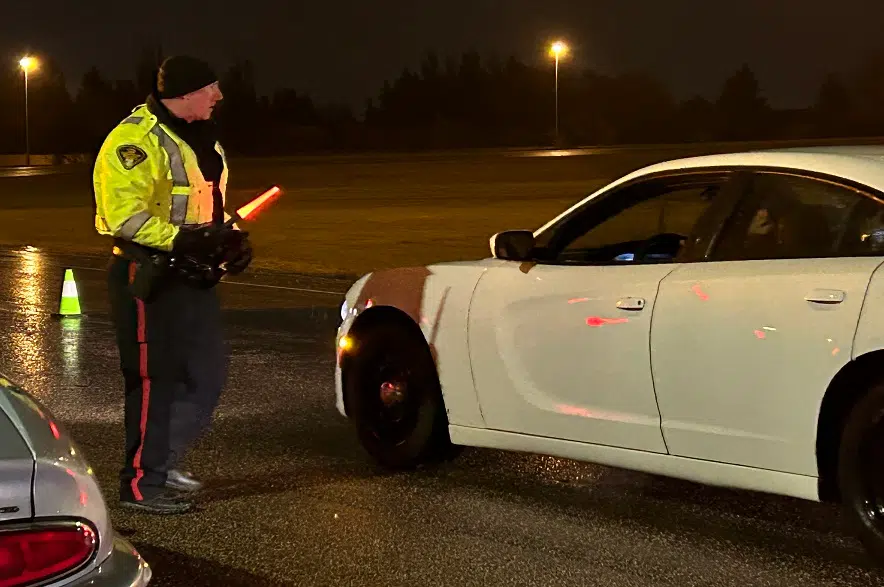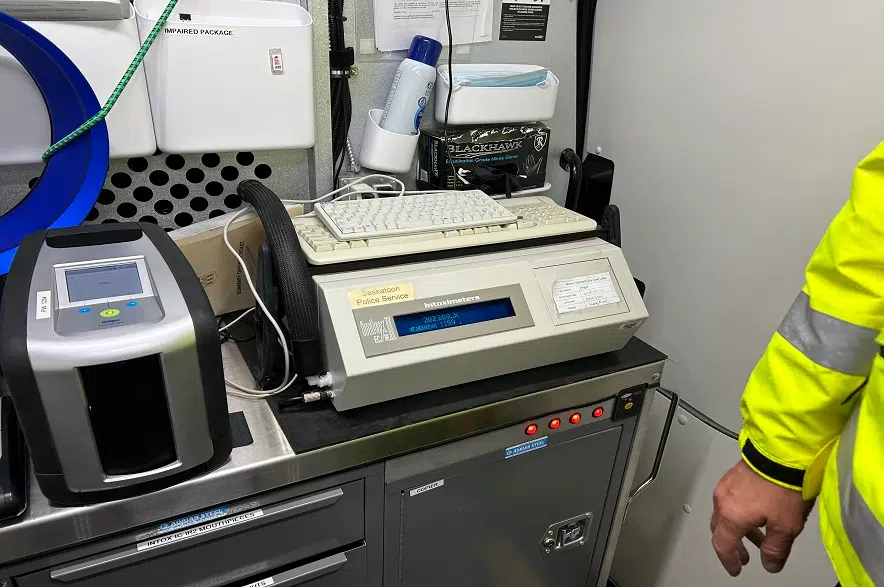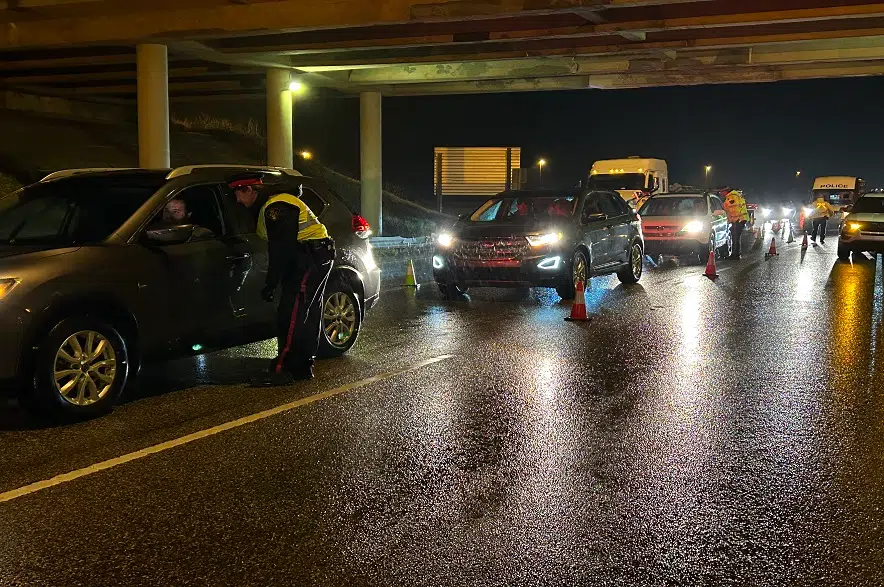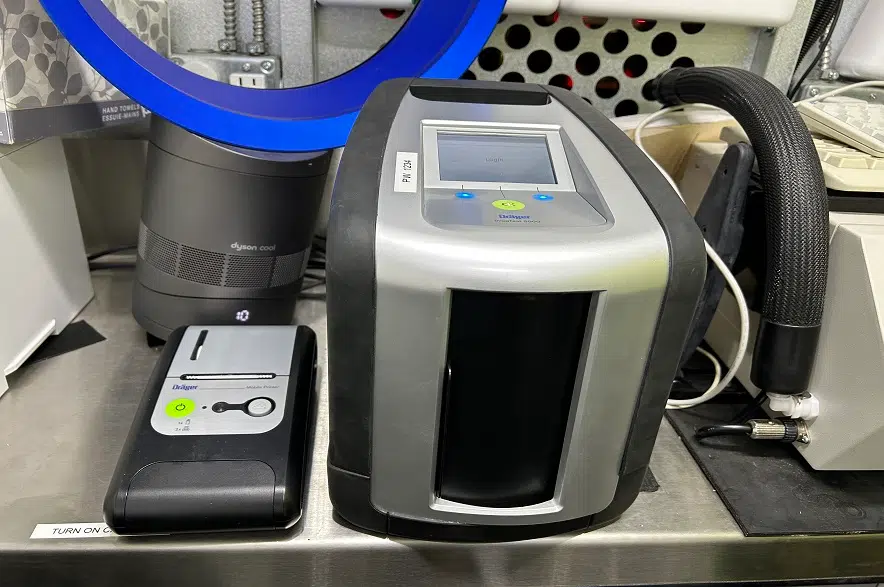On a cold and rainy Saturday night in Saskatoon, police set up a checkstop underneath an overpass just off Highway 11 heading north into the city limits.
Their goal for the checkstop was to make sure those on the road were driving safely and sober.
“Typically, we staff checkstops with nine police officers,” said Staff Sgt. Patrick Barbar with the Saskatoon Police Service. “We do about 35-40 large checkstops per year and then there’s a number of small checkstops that are done impromptu like. We’ll operate these for typically four hours.”
The checkstop 650 CKOM attended started at 9 p.m. and was functional until 1 a.m.

Saskatoon Police pull vehicle over during checkstop just off Highway 11 in Saskatoon. Photo: Shane Clausing
Barbar said the checkstops they do are pretty straight forward — drivers who are waved in are asked if they’ve been drinking or using drugs.
“It’s exactly what you’d expect,” Sgt. Barbar said. “How much have they had to drink? questions surrounding if they’ve used alcohol or cannabis or any other intoxicants. It’s an opportunity to use your other senses as well as to smell and observe. Typically, the interactions are 30 seconds or less.”
Barbar noted their best way of finding people under the influence of alcohol or drugs is by having a conversation with the driver.
“There’s no secrets here, it’s what we all know impairment looks like,” he added.
If police suspect the driver is under the influence, they ask them to pullover and investigate further.
Those investigated further have to do a breathalyzer test, and if that goes positive, they’re taken into a mobile drug and alcohol van to confirm the test.
“A roadside breath tester is just a pass, warn or fail. It’s just a device for further investigation. If they fail this, we’ll bring them into the van and (make them use) the actual breathalyzer. They can blow into it and gives us a precise reading. This is used as evidence for court,” he explained.
“One of the drug testing devices is a mouth swab on a little cartridge, but it collects saliva from the person, it’s a five minute test and the instrument tests for cocaine and THC,” he added.

Breathalyzer and drug testing machines inside of a special Saskatoon Police van used at checkstops. Photo: Shane Clausing
Sgt. Barbar said the van has been with the Saskatoon Police for the last four years and helps immensely. Previously, they had to take suspected intoxicated drivers to the police station to get an official reading.
The van also allows for police to complete the paper work and give the individual a ticket and court date.
The tests in the van are 100 per cent accurate, according to Sgt. Barbar.
If the suspect cannot drive home, their vehicle is towed away. If the person can’t find someone to pick them up, then they’re usually taken to jail for the night and typically released the next day once they’ve sobered up.
Cannabis intoxication on the rise
When you think of a checkstop, most will think of police looking for drivers who might have had too much to drink.
While that is true, Sgt. Barbar said from his personal experience, he notices more drivers getting pulled over because they’re high on cannabis.
“This is just observation based, but cannabis has surpassed alcohol as the main intoxicant that we deal with at sobriety checkpoints,” Sgt. Barbar stated.
October marks the five-year anniversary of the legalization of cannabis in Canada.
Sgt. Barbar suggests because police now have the proper tools to detect cannabis usage, they’re able to identify more drivers who might be under the influence of something that isn’t alcohol.
“Prior to legalization, we didn’t have the proper equipment to detect cannabis use. Obviously, we’re detecting more because we have the equipment now, so it’s really hard to draw a comparison from pre-2018 to post-2018 in terms of the amount of use,” Barbar explained. “But what I’m seeing is it’s almost unheard of to have a sobriety checkpoint where you don’t come across at least one driver who has used cannabis. Usually it’s several.”
On this night, police pulled over at least two people off the road. One of them blew over the legal limit for alcohol and had their license suspended for alcohol, while the other was tested for cannabis.
Sgt. Barbar suggests most people on the roads follow the rules and don’t drive under the influence, but their work remains essential.
“Are they getting the message? I would say a majority of the population is, but we still need to reach that percentage that isn’t.”












